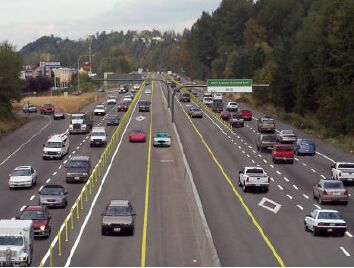 Seattle-area HOT lane [Graphic: Washington State DOT]
The Light Rail Now Project can be contacted at: Light Rail Now! |
The following commentary has been adapted from entries originally posted to The Overhead Wire Weblog on 10 September 2007 and the Daily Kos on 11 September 2007.
Rails to roads? The proposed new rules are alarming on a number of levels. Most notably, they downgrade the importance of land use and economic development despite congressional direction to the contrary, and they propose to redefine the definition of "fixed-guideway" to include transit funding for highway lanes that use tolling schemes – thus diverting rail transit money into roadway (tollway) development. Why is this important? To some extent, the FTA's proposed new rules would entrench policy positions advocated by notorious motor vehicle zealots and transit critics – folks such as the libertarian Reason Foundation and the Randal O'Toole/Wendell Cox cabal. The proposed rules ignore current transportation law regarding required project justification criteria and add new Federal intervention into the local decision-making process. "If finalized, the new rule-making policy will hamper American cities' ability to build new transit lines for the next 5 years! However, the fiscal year 2008 appropriations bill moving through congress is an opportunity to formally weigh in and stop or alter the proposed FTA rule. In a recent development, Senators Christopher Dodd and Richard Shelby have proposed an amendment to kill the FTA's new rules. Transit advocates may wish to communicate their views on this issue to their own Senators on the Transportation, Housing and Urban Development Subcommittee, which can be accessed at the following webpage: http://appropriations.senate.gov/transportation.cfm UPDATE: Light Rail Now has been informed that the Dodd-Shelby amendment was passed and has been added to the appropriations bill. However, President George W. Bush is threatening to veto this legislation. It's currently unknown whether there are sufficient votes in the US Senate to override such a veto. More details on the new rule-making The full text of the FTA's proposed rule can be found at the following URL: http://a257.g.akamaitech.net/7/257/2422/01jan20071800/edocket.access.gpo.gov/2007/E7-14285.htm Here are details on what the FTA's new rules would do: 1. FTA would allow High Occupancy Toll (HOT) lanes to qualify for New Starts funding
2. FTA would make the dreadful (and misnamed) cost-effectiveness index (CEI) the primary factor in deciding the fate of funding for New Starts projects This "index" is the same measure that is killing top-quality rail projects, such as the Tyson's Corner Metro extension (Washington, DC area) and has killed, or set back, light rail plans in Columbus, Ohio, Raleigh. NC, and elsewhere. Almost every city that is looking to build new transit projects is worried about qualifying under this seriously flawed measure, and now it's being made even stronger. This measure is the reason why Minneapolis's Central Corridor light rail project might not be able to tunnel under the University of Minnesota, and why locally backed expansion of light rail has been turned into less effective BRT projects in some Houston corridors. 3. FTA's rulemaking pushes cheap, not completely dedicated-guideway, bus projects The irony of the cost-effectiveness index is that, in reality, it fails to capture the full benefits and cost-effectiveness of a project. The index evaluates the cost-effectiveness of a light rail project versus corridor improvements such as bus rapid transit or improved local bus service. What this does is force cities to choose bus rapid transit projects over citizen-backed light rail projects that may have greater community benefits but also a higher initial price tag. Also, the measurements for the Very Small Starts program are set using the Southtown rapid bus project in Kansas City (which runs on city streets), and not rail or fixed-guideway BRT projects such as Los Angeles's Orange Line busway. 4. FTA reduces or ignores the importance of land use and economic development measures Congress elevated land use and added economic development as project justification criteria in SAFETEA-LU (the current federal transit authorization). The US Department of Transportation (DOT), however, ignores this and has combined them into one measure with a combined weight of 20% in the overall rating process. The FTA states that it is too costly to implement the economic development measure, but the cost and burden to grantees such as cities and transit agencies is not considered when local jurisdictions are required to adopt the FTA's travel demand models, which have many problems and questionable aspects. The fact that they use those models to determine the "cost-effectiveness" rating – which decides who gets funding – is a problem in itself, as this rating index can't address all the benefits of fixed-guideway transit. Furthermore, FTA argues that it's too difficult to separate land use from economic development, and that the increase in property values associated with proximity to transit is merely a result of improved time savings alone. We're sure many zoning offices and developers would be surprised to have these effects categorized so simplistically. 5. FTA's new policy could lower ratings for cities who are trying to address future rather than current congestion issues The FTA would like to measure the New Starts program by the benefits to highway users, but ignores the effect of induced demand, which means that, when you build a new transit project, the space from cars that are taken off the road by transit is filled by new cars. The aim of transit opponents – to push money from the transit program into congestion pricing schemes and not-so-rapid bus projects – would result in less useful transit projects in corridors that might have real future need. What can be done? Transit advocates and other proponents of improved public transportation might consider contacting their congressmen or senators, to request them to stop the FTA's proposed rule and give the Department of Transportation a clear directive that the FTA must:
Light Rail Now! website | ||
|
|
|||